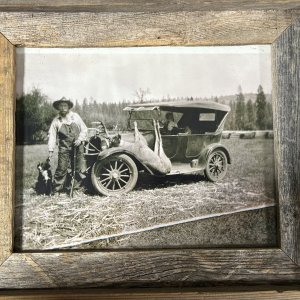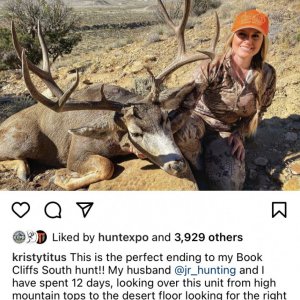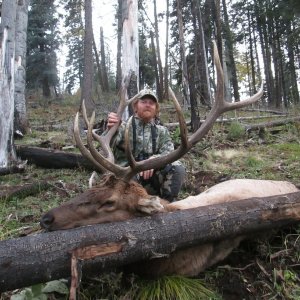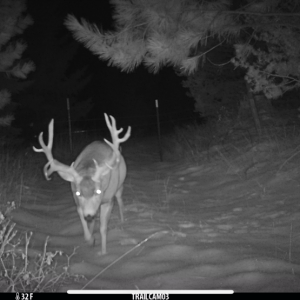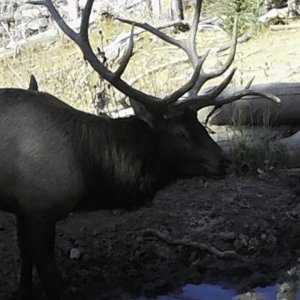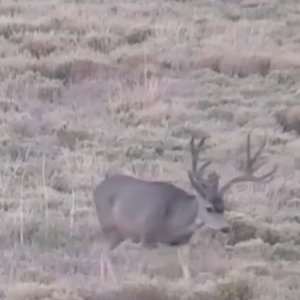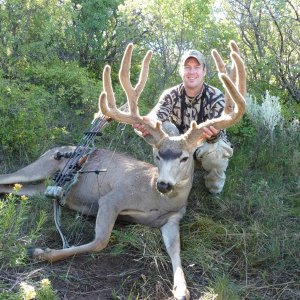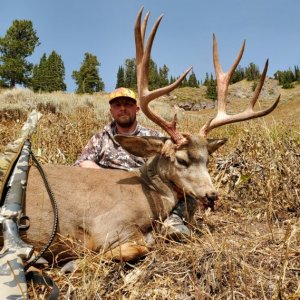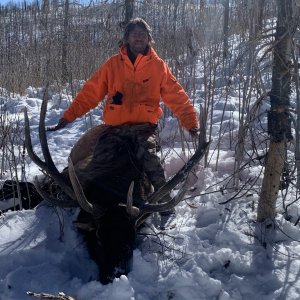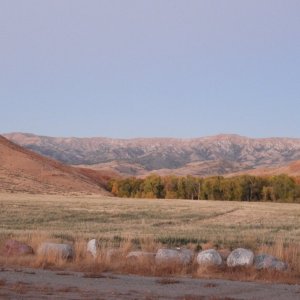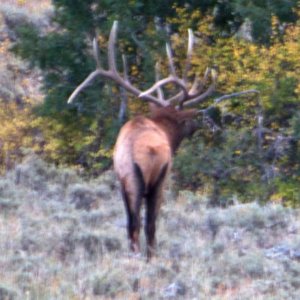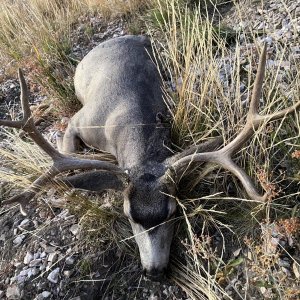Well for better or worse, here's the final draft I am going with and submitting to the commission. Pretty sure the Blazers odds of beating the Spurs 4 in a row are better than the odds of anything in this proposal making it past the Commissions garbage can. For a variety of reasons already touched upon, I give this thing really no chance. I don't believe OHA and OBH would ever support any short term reductions in opportunity, even if the long term benefits were clear as day. And unfortunately, there just aren't enough hunters willing to do any short term sacrifices necessary for Oregon to improve. If I had the know how I would start another state organization to try and push harder on ODFW since OHA won't.
I am hesitantly looking forward to giving comments at the commission meeting, hope I don't get booed. There is one thing I am really looking forward to though after pondering this thing for awhile. In the not to distant future my son and daughter will finally be old enough to join me on my annual trip to Western Wyoming. At some point during the 15 hour drive I am certain the whining will commence about "why do we have to drive clear to Wyoming".
That is going to be a wonderful teachable moment. Not only about the differences in game populations and management, but also about the different political/social viewpoints between the two states and the realities that result from those differences. And maybe most importantly, the importance of exercising your rights and trying to make a difference, as I did one time back in 2014.
May 12, 2014
Oregon Fish and Wildlife Commission
c/o ODFW Wildlife Division
4034 Fairview Industrial Drive SE
Salem, OR 97302
Members of the Commission,
Thank you for the opportunity to submit comments in regards to ODFW?s 2015-2017 Budget Development Process. A significant part of ODFW?s budget shortfall can be attributed to declining numbers of hunters purchasing licenses and tags. Decreasing deer/elk populations, and just as importantly, decreasing hunter interest due to a lower quality hunting experience have both contributed to this decline.
I believe Oregon is losing two classes of hunters. Casual hunters, who will lose interest easily if they are not successful on a regular basis or if they are seeing low numbers of game. Serious hunters, those who are seeking a high quality hunting experience where good numbers of game are available and there is a good possibility of finding a mature buck or bull. Oregon is competing with every other western state for the money spent by the serious class of hunter, and frankly, Oregon offers very little to entice those serious hunters, or severely limits there opportunity to spend their money here.
Following, are my suggestions on changes that could be enacted to improve ODFW?s revenue stream, and rebuild declining deer and elk populations. Vital to the success of any action adopted, is that increased revenue be used to offset the necessary reductions in tag numbers where needed.
1. For Eastern Oregon, consider a 3 pt. or better antler requirement for all buck deer hunts and/or reduce season days. There would be no loss of opportunity, i.e. no need to necessarily reduce tag numbers/revenue yet there should be an immediate improvement in buck survival and buck ratios. Please consider the success Washington State had when they adopted the 3 pt. or better policy for Eastern Washington. As well as the success Colorado had when they adopted policies which increased their buck ratios significantly. Demand for Colorado deer tags increased dramatically, creating an opportunity for increased revenue. The serious class of hunter desires the opportunity to see lots of deer and large bucks. If Oregon provides that, those hunters will spend money here.
2. For all elk units that do not currently have a spike only limitation in one of their hunts, change the bull bag limit to 3 pt. or better. Again, consider the success that Colorado and Montana have with this policy. There is no need to reduce opportunities/tags sold, yet bull ratios will immediately improve. There is overwhelming evidence that higher ratios of mature bulls in a population can improve overall herd productivity which could create a domino effect of more elk available, again providing an opportunity for increased revenue. Please consider Colorado?s very high calf to cow ratios in units where they have a similar 4 pt. or better rule in general hunting units with very high hunter pressure. They are consistently higher than Oregon?s calf/cow ratios. The majority of the harvest in Colorado?s 4 pt. or better general hunting units is 2.5 year old bulls, but obviously something is working with that approach as they have better bull and calf ratios than most Oregon units.
More branch antlered bulls available for harvest will again be of greater appeal to the serious class of hunter, creating the desire for them to spend their money here. This regulation could easily be adopted for the Cascade elk season units, Northside, Chesnimnus, Murderers Creek, Alsea, Sixes, Minam, etc.
3. Increase the non-resident quota to 10% for all controlled hunt tags, and publicize it. Oregon has one of the lowest non-resident quotas of all western states and is continually portrayed in a poor light by business?s such as Eastmans Hunting Journal, Huntin Fool magazine, Cabelas, and other tag brokering entities.
One non-resident deer tag is equal in revenue to approximately 16 resident deer tags. So just as an example, offering just 5 more nonresident tags in unit XX means you could reduce overall tags by approximately 75 and maintain the same revenue. 75 less tags means 25-40 more bucks should survive to become larger bucks, improve buck ratios, and begin to rebuild populations. As populations rebuild, this should mean more future opportunity, greater demand for tags, and again, increased revenue opportunity. Colorado is a prime example again of what is possible by improving buck ratios.
4. Increase the ability of hunters to harvest cougars, and establish a management objective of 3000-4000 cougars statewide. Increase mortality quotas in an effort to move the cougar population towards a population of 3000-4000. Certain hunters have developed the skill to effectively hunt cougars without dogs, so allow for a total of 3 cougar tags per individual to utilize those hunters who are effective.
Allow hunters to use their deer or elk tag to harvest a cougar, during the period/location where the deer or elk tag is valid. Imagine the benefits, potentially one elk or deer that is not harvested by the hunter, and certainly many times that not killed by the cougar. Idaho offers this option to non-residents.
5. Expand spring bear seasons to include the month of June. This could either be an expansion of existing season dates, or create additional controlled hunts. Idaho and Wyoming offer these expanded season dates with no ill effects to the bear or ungulate populations. This would allow for additional harvest on healthy bear populations, increased revenue, and particularly an increased opportunity for youth as school would not conflict in the latter part of June.
6. Once in a Lifetime tags. Two tags for Deer and two tags for Elk offered annually for every unit, with a season length of September 1 ? November 30. This a concept developed by Mike Morris from Bend, OR. Please refer to his proposal for the details.
7. Premier tags. Again this is a concept developed by Mike Morris, please refer to his proposal.
8. Quality hunts. For each unit create a controlled elk hunt that occurs Monday-Friday between the end of regular archery season and the start of the general/controlled buck seasons. This elk hunt would occur essentially at the end of September/first part of October each year.
Similar to the late season buck deer hunts that have been created for the White River and Mt. Emily units, establish a late season buck deer hunt for all units.
Establish 5-10 tags for each hunt. This would offer a very high quality deer or elk hunt which would be in very high demand.
9. Change timing of draw and pricing structure to capture more non-resident dollars.
IF, the Once in a lifetime tags, Premier tags, or Quality hunts as described above become reality, and IF, the non-resident quota increases to 10% of tags, there will be a huge interest from non-residents in applying in Oregon. We will have very high quality hunts available and they will have what now seems like a reasonable chance to actually draw.
Similar to what Wyoming does, I would eliminate the requirement for non-residents to purchase a license in order to purchase preference points. Instead price non-resident points at $50 for elk/deer/antelope. Wyoming brings in Millions of dollars from non-residents purchasing points only. That is millions of dollars available for programs/management without harvesting a single animal.
Since Oregon is competing with all the other western states for hunters, move the drawing to February or early March with results available by mid March. This puts Oregon first in line for most of the western states drawing periods, and first in line for hunter dollars. Those hunters who apply in multiple states, can apply, get there results from Oregon, then move on to other states.
Create a tiered pricing system for non-resident deer and elk tags based on the number of preference points required to draw the tag. My suggestion would be as follows:
0-4 pts. 5-8 pts. 9+ pts.
Deer $350 $650 $950
Elk $525 $1050 $1575
In 2014, thousands of non-resident hunters paid Wyoming over $1000 for a General season elk tag. Not a high demand controlled hunt, just a General season tag. Oregon is clearly undervaluing some of the tags we currently offer, and could offer many more valuable tags if changes are implemented.
10. Convert some controlled spike only elk hunts to 3 pt. or better. Mike Morris has a proposal for conversion of the spike tags in the Wenaha, Mt. Emily and Walla Walla units. This proposal is for the Powers, Sled Springs, and Snake River units.
Application history clearly demonstrates that hunters would much rather hunt branch antlered bulls, and ODFW should capitalize on non-resident hunters willingness to pay for that opportunity. Here is an example of the 2013 revenue stream from Sled Springs archery bull elk tags. The any bull tag required 8 points for a non-resident to draw, the spike tag could be drawn with 0 points.
2013 Sled Springs Archery elk. 372 total tags.
Resident tags issued: 358 @ $42.50 = $15,215
Nonresident tags issued: 14 @ $508.50 = $7,119
Total Revenue: $22,334
Here is what the revenue stream could look like if Non-residents were offered 10% of tags, and were priced according to the proposed tiered system. This example assumes a total of 300 tags issued.
Resident tags issued: 270 @ $42.50 = $11,475
Nonresident tags issued: 30 @ $1050 = $31,500
Total Revenue: $42,975
This scenario provides several benefits. Increased revenue stream for ODFW, the ability to temporarily reduce tag numbers to boost bull ratios and herd productivity, the opportunity for Oregon hunters to pursue branch antlered bulls instead of spikes which application history illustrates is clearly their preference.
11. Create Cascades hunting opportunity, unique to Oregon.
For rifle hunters with limited time available for hunting trips, one of the advantages of other western states such as Montana, Idaho, Colorado and Wyoming is the ability to hunt for deer and elk at the same time. No real opportunity exists for that in Oregon. A hunt that may be of great appeal to residents and non-residents is the ability to rifle hunt for elk and blacktail deer at the same time. Such an opportunity does not currently exist anywhere, and would certainly be unique to Oregon.
My proposal is this. In the Santiam, McKenzie, Indigo, Dixon, Rogue, and Evans Creek units establish October 31 as the end of the Western Oregon General Deer rifle season. To compensate for that loss of opportunity at the end of the season, allow Cascade elk tag holders with unused Western General Deer rifle tags or High Cascade tags, the opportunity to hunt deer in the above mentioned units during the Cascade elk season.
Thank you for the opportunity to submit these proposals, and I hope you will seriously consider these or any others you receive that will benefit Oregon?s big game populations and future generations of Oregon hunters.
Respectfully,
Tony Pranger
Oregon City, OR

